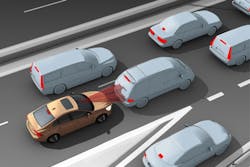Steve Abrantes knows first-hand that vehicles capable of avoiding collisions without driver assistance will have an impact on the collision repair industry. The manager of San Diego Volvo’s collision center has already seen a reduction in Volvo XC60 crossovers since a crash prevention system became standard on the vehicle in 2010.
“We’re not seeing that car in here,” he says of the vehicle, equipped with a system called City Safety. “The avoidance system is costing us money because we’re not seeing those cars with the same frequency as the previous models.”
Though he suspects any repairs involving the avoidance system could earn his business a bit more than a traditional fix because of the expensive and intricate components, he has yet to find out. Abrantes says he plans to start tracking repairs on the model to see just what he’s earning—or missing—because of the system.
It’s a predicament many repairers could find themselves in as crash avoidance technology becomes more widespread. If recent studies are any indication, the systems could prevent huge numbers of crashes each year if they become standard in every vehicle.
An October report from the Institute of Electrical and Electronics Engineers (IEEE) estimated that crash avoidance technology could eliminate all accidents caused by driver error. That’s a whopping 90 percent of crashes.
An earlier study by the Highway Loss Data Institute (HLDI), which evaluated the Volvo XC60 with City Safety technology, found that claims under property damage liability coverage were filed 27 percent less often for the vehicle compared to other midsize luxury SUVs. Claims under bodily injury liability were filed 51 percent less often. And overall claim frequency for the XC60 was lower than for all other midsize luxury SUVs combined, as well as other Volvos, under every type of insurance coverage.
The XC60’s system detects the distance and speed of other vehicles within 18 feet of its front bumper when traveling between 2 and 19 mph day or night, and automatically brakes if a crash is imminent.
Susanna Gotsch, industry analyst for CCC Information Services, says such systems will likely hurry the country’s accident decline, which is already dropping 1–2 percent a year for a host of reasons.
“I think it’s going to speed up a trend that we’re already seeing,” Gotsch says. “It will certainly drive down accident frequency, though I’m not sure that it will eliminate accidents.”
Whether all crash avoidance systems will work as designed has yet to be seen, she says. As long as there’s a human element, there will always be a danger of collision.
She says shops should be ready to learn about new crash avoidance systems as they are release_notesd, since repairs to those systems—which can include cameras, sensors, microprocessors and other components—will probably become commonplace. They could also make for more expensive repairs, she says, but costs will inevitably come down as production ramps up.
Another unknown, Gotsch says, is whether auto manufacturers will be held liable for repairs if an avoidance system fails to prevent a crash.
“There’s adaptation that will have to take place,” says Gotsch, noting that crash avoidance is beginning to take precedence over crash worthiness. “It’s good for people to be aware of what’s coming, anticipate that, and plan for that.”
That’s exactly what Abrantes is doing at San Diego Volvo.
“We’re seeing [the systems] in the premium brands now,” he says. “But they will certainly impact our bottom line as they become more common.”




